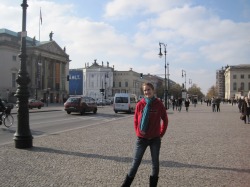
Growing up, my mom always told me that I was born the week that the Berlin Wall came down. She always thinks of me, she tells me, when she hears about the Wall. Strangely enough, I never really knew what this meant. I had no idea what the Berlin Wall stood for, and why it’s destruction was so significant. But after reading Anna Funder’s Stasiland and making a trip to Berlin last week, I learned firsthand what the fall of the Wall truly meant.
On Friday morning, we started our trip with a bus tour of the city, taking in all of the sights from West Berlin to East Berlin. We had an interesting German tour guide who had some insightful one-liners (i.e. “There is a candy store where you can go get shveets for the shveety”) and strange insights (i.e. “There was a bombing that killed more than 20,000 people…too bad”). I expected to see a significant difference between the two – a bleaker, more cold atmosphere in the East where the Stasi regime had taken control, and a more artistic and liberated West. But to tell you the truth, it was difficult to tell the difference between the two sides. They have already done a tremendous job of moving forward and filling the city with life. The streets were bustling with people and shops and restaurants. It was much more dynamic than I had anticipated. I expected to see stiff German citizens marching the streets in dark clothing. But it was a lively and beautiful city. We passed spectacular churches, monuments, and museums with architecture ranging from modern business buildings to historical row houses with high ceilings. Of course, one of my favorite things about the city was the presence of the Berlin Bears, colorful statues scattered throughout the city much like the lovely Crabs in Maryland. All of the souvenir shops had lovable stuffed bears that were tough to resist.

We stopped at Checkpoint Charlie, the spot where the division between East and West was made and officials used to stand guard. It was undoubtedly a major tourist spot with stands selling fur hats, army jackets, and even DDR passport stamps. But thinking about the history of the location that separated two very different worlds was remarkable.
Throughout the city, there is still a line that runs along the sidewalk where the Wall used to stand. It’s eerie to look down and think of the physical barrier that used to loom over the people of the Berlin.

It was positively surreal to touch the wall with my own hand, and to see the extraordinary display of artistic spirit that the standing stretch of the structure has become in what is called the East Side Gallery. The wall is covered in a series of different paintings, each with a unique identity using various colors, images and messages. The art on the surface of the wall represents more than just artistic talent, but also the perseverance of the German people. Rather than destroying reminders of the past, the people have turned this section into a tribute to overcoming the struggles of former division and suppression. The beautiful images and words running along the wall acknowledge overcoming the past, and confidently moving forward.
Although it was a bitterly cold weekend and there was not nearly enough time to take in all of the beautiful sights, it was truly special to finally connect with this legendary place that has been such a mystery to me.



 RSS Feed
RSS Feed